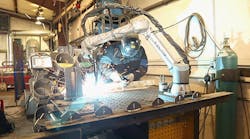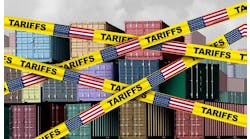The configuration and implementation of controls automation often require a degree of expertise that many machine builders, system integrators or end users don’t have readily available. This can be due to unfamiliarity with a particular type of technology or brand, a new application or even lack of technical knowledge because of staffing shortages. Whatever the reason, help is often available in the form or technology providers that are intimate with the products and can provide assistance.
“Customers should be able to see their technical options clearly spelled out, along with pricing and product availability,” says Brian Jaeger, technical content developer, Maple Systems. “With the constantly changing dynamics of supply issues in 2021, having product options dramatically helped improve lead times for our customers. Having a sales team that could walk customers through their product options to create a timely deliverable solution has been key.”
Also read: COVID-19 pandemic impacts supply chain, Industry 4.0 and 5G
James Zhang, vice president of market development and connected operations at PTC, is seeing two trends from customers seeking technology expertise from suppliers. “First, companies are expecting solutions to focus on the most impactful problem they have in their factories, coupled with the expertise to develop a prescriptive approach to address an issue they may have on the shop floor in a factory, for example,” he says. “Companies are expecting more than technology offerings, but instead they would like to know how to adopt these technologies and maximize their value, with speed and at scale. Second, companies are accelerating the convergence of IT and OT. They’re expecting open platforms to connect data to the cloud, to add more intelligence and edge.”
The rise in robotics has spawned a need to integrate them, and often that means specialized application-related expertise, notably with collaborative robots (cobots).
“Like their large, traditional robot counterparts, cobots have also spawned a new class of integrators specially adapted to the needs of SMEs who wish to leverage automation,” explains Joe Campbell, senior manager of applications development and strategic marketing at Universal Robots. “Unlike traditional integrators, these ‘lean integrators’ are built for speed and cost/overhead containment, rather than handling large, custom-engineered projects; and they typically specialize in serving highly targeted applications or markets (Figure 1).” These lean integrators are further leveling the playing field for SMEs in highly innovative and cost-effective ways, says Campbell.
“If you sell it, you should be able to support it,” says Brandon Ellis, owner and president of elliTek. “From general product knowledge to the ability to implement, suppliers should be expected to configure and apply technologies, even with platforms that aren’t on their line card but are within reason.”
Machine builders, system integrators and end users should expect suppliers to be experts in integration and technology on all levels that touch their own products, says Kristian Hulgard, general manager, Americas, OnRobot, which launched Learn OnRobot to educate and share knowledge about not only its own products, but also how to integrate them to specific robots and environments in different applications. It's a free online training platform that guides users, step-by-step, through the process of designing and deploying cobot applications featuring tools such as grippers, vision cameras, processing kits and sensors in setups with cobot and light-industrial-robot brands, explains Hulgard.
“Our customers are looking for more advanced technical solutions support, including more detailed support on the identification of products to meet specific needs, as well as with the deployment or integration in their applications,” says Ken Bradley, president, Allied Electronics & Automation. “From the simple to the complex, our responsibility as a distributor is to provide our customers with the answers to their questions, saving them time and making their lives easier.”
The level of expertise of the end user should dictate the expectations from a supplier, notes Freeman Smith, founder, Nufactur. “At minimum, the supplier should be comfortable with the quickly changing landscape of industrial communication protocols,” he explains.
“With the capabilities and specifications of Ethernet-based communication changing so rapidly, the supplier needs to understand what's new and ensure that the products they're supplying will be compatible with the end user's system,” emphasizes Smith.
“Suppliers of automation components and systems must have the ability to support their customers on multiple levels,” says Bob White, technical sales manager, Nippon Pulse, “first, by supporting the product and technology they supply, but also having knowledge of adjacent technologies utilized in the machine, and how they interact with the supplier’s product. It is imperative a supplier know how its product interacts and affects other elements in the machine to deliver optimal performance.”
Manufacturers have a lot of resources to help with selecting, configuring and implementing technology products. “It starts with our channel/distributor partners and our sales team,” explains John MacDougall, manager of industrial channel sales, Phoenix Contact USA. “We’ve got a lot of great resources in our distribution channel and field sales organization that can answer many of the customer’s questions. The use of digital tools has given us the ability to be more agile and better support customers.”
Suppliers in today’s climate need to have application engineers at the ready as technical consultants, stresses Arun Sinha, director of business development, Opto 22. “The trend for some time now has been for customers to move away from distributors or suppliers that are purely transactional. There are many studies available that suggest that, with the availability of information online, potential customers are typically about 70% down the path of their buying journeys before they make contact with a person. So, when they do, the supplier should have the ability to act as a technical advisor that can help apply their products to the specific application or problem the customer is trying to solve.”
This requires not only knowledge of the automation products manufactured or sold, but also a peripheral knowledge of the sensors, devices, networks and software that the control system will be connecting to, explains Sinha.
“A good supplier should be able to offer alternative technology solutions for the various configurations required, as well as understand the application and implementation of these automation solutions to be able to offer other alternatives that can meet the requirements,” says Nathan Smith, channel sales director, Advantech.
Of course, it’s always wise to assess the financial implications of a technology run amok. Look for help before you leap into action.
“A precision automation project can easily run into the multi-millions in terms of project budget,” says Brian O’Connor, vice president, marketing, Aerotech. “Making a mistake when selecting and designing the solution is costly.”
Suppliers should be able to recommend and build a solution for customers, says Tim Fredricks, channel sales manager, Advantech. “Our channel partners are gathering the customers; we need to have superior expertise to help them close the deal,” he explains.
“The current generation of people adopting automation are pretty self-sufficient for basic projects,” says Eric Wendt, director of automation and electrical products for Digi-Key Electronics. “For the most part, if they want to do a more simplistic implementation, they are accustomed to figuring out how to do it themselves by watching videos on distributor or supplier websites, talking to others in forums and researching online.”
Wendt still sees a great deal of need for expertise from suppliers and distributors for more complex or larger projects. “We’re always looking for new tools and features we can provide to customers to help them find the expertise they need,” he says.
“End users can look to suppliers to share best practices and trends across their customer base and take a consultative approach,” says Aric Prost, senior global director OEM at Stratus Technologies. “A good supplier knows how a product fits into the end user’s architectures and understands the context, environment and business goals. A deep partnership and dialogue with distributors and system integrators is critical for suppliers to develop solutions that manufacturers and machine builders are looking for.”
The result is the ability of suppliers to then offer turnkey, pre-tested and validated architectures that are proven and can be deployed quickly to solve specific challenges, explains Prost. They should also look for fast payback on those investments and compounding return on investment. Equally important are the ongoing maintenance and management of aftermarket costs. Teams are looking to vendors to provide the service expertise, rather than trying to build in-house expertise about a vendor product, he says.
“Suppliers need to be able to give not only thorough, constructive information on their own product offerings, but also to be able to consult on application-specific use cases and offer input on best practices,” says Jim Wilmot, manager, Simatic PLC products, Factory Automation business unit, Siemens Industry. “Suppliers should act as partners to the end users, offering educational materials and direct consultation on how to optimize their hardware and process choices.”
As technology is constantly changing and improving, it’s understood that suppliers must educate designers and manufacturers on industrial products and solutions being offered to the marketplace, says Dave Cameron, director of sales—automation & electrification, Bosch Rexroth. “Many people are self-serving in searching out technology to start,” he explains. “Video demonstrations, animations and short articles showing the new technology, applications and the values they provide are key. The traditional sales process, whether it’s virtual or in person, is still important and allows the active dialog about how the latest technology is being used and how the pieces can fit together to provide a new solution and benefit. Offering expertise in the design stages relates to expected intuitive online tools for selection, forums for getting answers and help on specific items and traditional in-person or virtual engineering resources for designer needs.”
Making high-tech industrial products intuitive and easy to apply, like in many consumer areas, is where it is heading, predicts Cameron.
“In today’s, fast moving technology universe, it is nearly impossible for our partners and customers to stay up on all the latest developments,” says Jon Towslee, senior director of iFactory sales, Advantech. “We as a technology supplier need to provide education, awareness and technical support not only on new products and features, but also on new applications of our technology.”
The best supplier relationships are those that are with groups interested in learning about new technologies and that recognize that AI-powered robotics will be a driving force within the automation industry in the decades to come, says Stephen McKinley, co-founder and vice president of operations at Ambi Robotics. “This learning is bi-directional,” he explains. “Just as we are eager to educate distributors about what our tech and team can do, we aim to be similarly voracious in learning about what other offerings distributors have within their quiver. The Ambi Robotics engineering team is brilliant at repurposing automation components from lower-cost sectors of the market, such as automotive and construction, for example, for use in our warehouse robotics systems. Often, we simply wouldn’t know what great options are out there without an active dialog between our manufacturing team, engineering team and our suppliers.”
Honeywell takes a slightly different approach, entrusting its distributors. “We design our products and supporting tools with the intention that our distributors can do all their own configurations, quoting and order management,” says Lance Fuhr, director of channel excellence, Honeywell Process Solutions.






